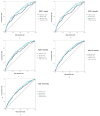Predictive Feasibility of the Graz Malnutrition Screening, Controlling Nutritional Status Score, Geriatric Nutritional Risk Index, and Prognostic Nutritional Index for Postoperative Long-Term Mortality After Surgically Treated Proximal Femur Fracture
- PMID: 39770903
- PMCID: PMC11676286
- DOI: 10.3390/nu16244280
Predictive Feasibility of the Graz Malnutrition Screening, Controlling Nutritional Status Score, Geriatric Nutritional Risk Index, and Prognostic Nutritional Index for Postoperative Long-Term Mortality After Surgically Treated Proximal Femur Fracture
Abstract
Background: Hip fractures are a prevalent and serious health issue, particularly among the elderly population aged >65 years. These injuries are associated with elevated rates of postoperative complications and mortality, significantly diminishing patients' quality of life in both the short- and long-term. The prognosis for recovery is further exacerbated in individuals with signs of malnutrition. The primary objective of this study was to evaluate the predictive value of four distinct nutritional assessment scores in relation to postoperative mortality in patients undergoing surgical intervention for hip fractures at 1, 3, 6, 12, and 24 months.
Methods: This observational study included patients admitted to the Department of Traumatology at the Medical University for the surgical management of hip fractures between January 2019 and November 2021. Nutritional assessment scores were derived from a retrospective analysis of clinical data. The statistical correlation between nutritional scores and postoperative mortality outcomes was rigorously evaluated.
Results: Logistic regression analysis revealed a statistically significant correlation (p < 0.01) between all four nutritional scores and postoperative mortality risk. The malnourished cohorts demonstrated a markedly higher risk of mortality compared to those with adequate nutritional status, as indicated by the following risk ratios: Graz Malnutrition Screening (risk ratio = 2.53-1.68), Prognostic Nutritional Index (risk ratio = 2.44-1.74), Geriatric Nutritional Risk Index (risk ratio = 2.05-1.58), and Controlling Nutritional Status (risk ratio = 2.34-1.46). Despite these findings, the receiver operating characteristic analysis yielded area under the curve (AUC) values ranging from 0.64 to 0.68, indicating limited predictive power.
Conclusions: Although a significant correlation existed between the evaluated nutritional scores and postoperative mortality, the predictive value of these scores was quantitatively low. No single nutritional assessment tool has emerged as a strong predictor of postoperative outcomes in this patient population. Consequently, implementation of any specific nutritional screening tool for standard assessment in patients with hip fractures is not recommended at this time. Nevertheless, given the established association between malnutrition and postoperative mortality, a comprehensive evaluation of nutritional status is advisable and further research is needed.
Keywords: CONUT; GMS; GNRI; PNI; hip fracture; malnutrition; mortality; risk prediction.
Conflict of interest statement
The authors declare that they have no conflict of interest.
Figures
Similar articles
-
Predictive Validity of Mortality after Surgically Treated Proximal Femur Fractures Based on Four Nutrition Scores-A Retrospective Data Analysis.Nutrients. 2023 Jul 28;15(15):3357. doi: 10.3390/nu15153357. Nutrients. 2023. PMID: 37571292 Free PMC article.
-
Acute phase nutritional screening tool associated with functional outcomes of hip fracture patients: A longitudinal study to compare MNA-SF, MUST, NRS-2002 and GNRI.Clin Nutr. 2019 Feb;38(1):220-226. doi: 10.1016/j.clnu.2018.01.030. Epub 2018 Feb 15. Clin Nutr. 2019. PMID: 29456030
-
Usefulness of nutritional assessment using Geriatric Nutritional Risk Index as an independent predictor of 30-day mortality after hip fracture surgery.Orthop Traumatol Surg Res. 2022 Sep;108(5):103327. doi: 10.1016/j.otsr.2022.103327. Epub 2022 May 14. Orthop Traumatol Surg Res. 2022. PMID: 35577274
-
Association between nutritional indices and mortality after hip fracture: a systematic review and meta-analysis.Eur Rev Med Pharmacol Sci. 2023 Mar;27(6):2297-2304. doi: 10.26355/eurrev_202303_31763. Eur Rev Med Pharmacol Sci. 2023. PMID: 37013747
-
Prognostic Role of Serum Albumin, Total Lymphocyte Count, and Mini Nutritional Assessment on Outcomes After Geriatric Hip Fracture Surgery: A Meta-Analysis and Systematic Review.J Arthroplasty. 2019 Jun;34(6):1287-1296. doi: 10.1016/j.arth.2019.02.003. Epub 2019 Feb 11. J Arthroplasty. 2019. PMID: 30852065
Cited by
-
Threshold effect of prognostic nutritional index on mortality in geriatric hip fracture patients.Sci Rep. 2025 Jul 1;15(1):22241. doi: 10.1038/s41598-025-08123-x. Sci Rep. 2025. PMID: 40596547 Free PMC article.
-
The Value of Systemic Inflammatory Index and Nutritional Marker in Predicting Acute Calculus Cholecystitis and Its Severity.J Inflamm Res. 2025 Jul 19;18:9505-9521. doi: 10.2147/JIR.S521080. eCollection 2025. J Inflamm Res. 2025. PMID: 40703643 Free PMC article.
References
-
- Sing C.W., Lin T.C., Bartholomew S., Bell J.S., Bennett C., Beyene K., Bosco-Levy P., Bradbury B.D., Chan A.H.Y., Chandran M., et al. Global Epidemiology of Hip Fractures: Secular Trends in Incidence Rate, Post-Fracture Treatment, and All-Cause Mortality. J. Bone Miner. Res. 2023;38:1064–1075. doi: 10.1002/jbmr.4821. - DOI - PubMed
Publication types
MeSH terms
Grants and funding
LinkOut - more resources
Full Text Sources
Medical



